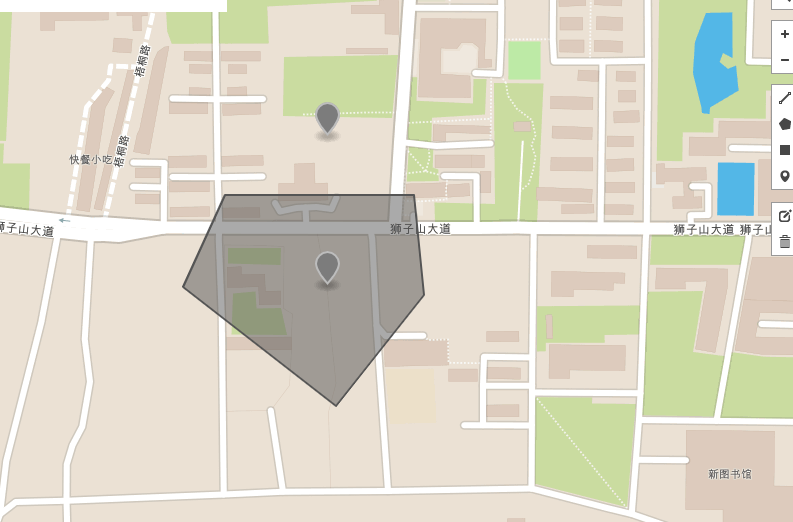最近在工作中遇到了这个一个需求,用户设定地理围栏,后台获取到实时位置信息后通过与围栏比较,判断是否越界等。
这个过程需要用到数据协议为GEOjson,通过查阅资料后,发现python的shapely库可以非常简单的解决这个问题,接下来演示一下我处理这个问题的过程。
测试数据:
通过http://geojson.io/来获得测试数据,如下图,在地图上绘制了一个多边形设为地理围栏,分别取了围栏内外两个点来进行测试。

得到GEOjson数据如下:
{
"type": "FeatureCollection",
"features": [
{
"type": "Feature",
"properties": {},
"geometry": {
"type": "Polygon",
"coordinates": [
[
[
114.3458104133606,
30.476167529462785
],
[
114.34512376785278,
30.475575748963195
],
[
114.34576749801636,
30.474540124433936
],
[
114.3467652797699,
30.475363076967565
],
[
114.34693694114685,
30.476102803645833
],
[
114.3458104133606,
30.476167529462785
]
]
]
}
},
{
"type": "Feature",
"properties": {},
"geometry": {
"type": "Point",
"coordinates": [
114.34605717658997,
30.475584995561178
]
}
},
{
"type": "Feature",
"properties": {},
"geometry": {
"type": "Point",
"coordinates": [
114.346604347229,
30.476518897432545
]
}
}
]
}
安装shapely
本测试基于python——python3.6
$ pip install shapely
windows安装shapely会报错
shapely解析地理围栏
话不多说直接上代码
from shapely.geometry import Point
from shapely.geometry.polygon import Polygon
point = Point(0.5, 0.5)
polygon = Polygon([(0, 0), (0, 1), (1, 1), (1, 0)])
print(polygon.contains(point))
下面是实际的实例:
from shapely.geometry import Point
from shapely.geometry.polygon import Polygon
polygon_data= [
[
114.3458104133606,
30.476167529462785
],
[
114.34512376785278,
30.475575748963195
],
[
114.34576749801636,
30.474540124433936
],
[
114.3467652797699,
30.475363076967565
],
[
114.34693694114685,
30.476102803645833
],
[
114.3458104133606,
30.476167529462785
]
]
point1 = Point([114.34605717658997,30.475584995561178])
point2 = Point([114.346604347229,30.476518897432545])
polygon = Polygon(polygon_data)
print(polygon.contains(point1))
print(polygon.contains(point2))
输出结果:
True
False
这样一来我们就快速的实现了,目标点是否在地理围栏内的判断。
总结
Python还是挺好用的:)